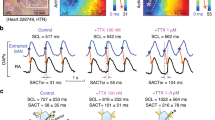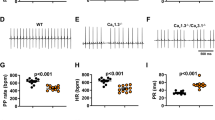Abstract
Patients with hyperhomocysteinemia (HHcy), or elevated plasma homocysteine (Hcy), are at higher risk of developing arrhythmias and sudden cardiac death; however, the mechanisms are unknown. In this study, the effects of HHcy on sinus node function, atrioventricular conduction, and ventricular vulnerability were investigated by electrophysiological (EP) analysis, and the role of magnesium (Mg2+), an endogenous N-methyl-d-aspartate (NMDA) receptor antagonist, in attenuating EP changes due to HHcy was explored. Wild-type mice (WT) and mice receiving Hcy in the drinking water for 12 weeks (DW) were subjected to electrocardiographic and EP studies. DW compared to WT had significantly shorter RR, PR, QT, and HV intervals, corrected sinus node recovery times (CSNRT), Wenckebach periodicity (WP), atrioventricular nodal effective refractory periods (AVNERP), and right ventricular effective refractory periods (RVERP). To examine the role of Mg2+ in mitigating conduction changes in HHcy, WT, DW, and heterozygous cystathionine-β-synthase knockout mice (CBS +/−) were subjected to repeat EP studies before and after administration of low-dose magnesium sulfate (20 mg/kg). Mg2+ had no effect on EP variables in WT, but significantly slowed CSNRT, WP, and AVNERP in DW, as well as WP and AVNERP in CBS +/−. These findings suggest that ionic channels modulated by Mg2+ may contribute to HHcy-induced conduction abnormalities.



Similar content being viewed by others
References
Maldonado, C., Soni, C. V., Todnem, N. D., Pushpakumar, S., Rosenberger, D., Givvimani, S., et al. (2010). Hyperhomocysteinemia and sudden cardiac death: Potential arrhythmogenic mechanisms. Current Vascular Pharmacology, 8, 64–74.
Rosenberger, D., Gargoum, R., Tyagi, N., Metreveli, N., Sen, U., Maldonado, C., et al. (2011). Homocysteine enriched diet leads to prolonged QT interval and reduced left ventricular performance in telemetric monitored mice. Nutrition, Metabolism and Cardiovascular Diseases, 21, 492–498.
Lipton, S. A., Kim, W. K., Choi, Y. B., Kumar, S., D’Emilia, D. M., Rayudu, P. V., et al. (1997). Neurotoxicity associated with dual actions of homocysteine at the N-methyl-D-aspartate receptor. Proceedings of the National Academy of Sciences, 94, 5923–5928.
Gill, S. S., Pulido, O. M., Mueller, R. W., & McGuire, P. F. (1998). Molecular and immunochemical characterization of the ionotropic glutamate receptors in the rat heart. Brain Research Bulletin, 46, 429–434.
Mueller, R. W., Gill, S. S., & Pulido, O. M. (2003). The monkey (Macaca fascicularis) heart neural structures and conducting system: An immunochemical study of selected neural biomarkers and glutamate receptors. Toxicologic Pathology, 31, 227–234.
Gill, S., Veinot, J., Kavanagh, M., & Pulido, O. (2007). Human heart glutamate receptors—implications for toxicology, food safety, and drug discovery. Toxicologic Pathology, 35, 411–417.
Winter, C. R., & Baker, R. C. (1995). L-glutamate-induced changes in intracellular calcium oscillation frequency through non-classical glutamate receptor binding in cultured rat myocardial cells. Life Sciences, 57, 1925–1934.
Huang, M. H., Wolf, S. G., & Armour, J. A. (1994). Ventricular arrhythmias induced by chemically modified intrinsic cardiac neurones. Cardiovascular Research, 28, 636–642.
D’Amico, M., Di, F. C., Rossi, F., & Rossi, F. (1999). Arrhythmias induced by myocardial ischaemia-reperfusion are sensitive to ionotropic excitatory amino acid receptor antagonists. European Journal of Pharmacology, 366, 167–174.
Mayer, M. L., Westbrook, G. L., & Guthrie, P. B. (1984). Voltage-dependent block by Mg2+of NMDA responses in spinal cord neurones. Nature, 309, 261–263.
Hart, C. Y., Burnett, J. C, Jr, & Redfield, M. M. (2001). Effects of avertin versus xylazine-ketamine anesthesia on cardiac function in normal mice. American Journal of Physiology Heart and Circulatory Physiology, 281, H1938–H1945.
Charbit, B., Samain, E., Merckx, P., & Funck-Brentano, C. (2006). QT interval measurement: Evaluation of automatic QTc measurement and new simple method to calculate and interpret corrected QT interval. Anesthesiology, 104, 255–260.
Zappacosta, B., Persichilli, S., Minucci, A., Scribano, D., Baroni, S., Fasanella, S., et al. (2006). Evaluation of a new enzymatic method for homocysteine measurement. Clinical Biochemistry, 39, 62–66.
Crunelli, V., & Mayer, M. L. (1984). Mg2+ dependence of membrane resistance increases evoked by NMDA in hippocampal neurones. Brain Research, 311, 392–396.
Poddar, R., & Paul, S. (2009). Homocysteine-NMDA receptor-mediated activation of extracellular signal-regulated kinase leads to neuronal cell death. Journal of Neurochemistry, 110, 1095–1106.
Doronzo, G., Russo, I., Del Mese, P., Viretto, M., Mattiello, L., Trovati, M., et al. (2009). Role of NMDA receptor in homocysteine-induced activation of mitogen-activated protein kinase and phosphatidyl inositol 3-kinase pathways in cultured human vascular smooth muscle cells. Thrombosis Research, 125, e23–e32.
Qureshi, I., Chen, H., Brown, A. T., Fitzgerald, R., Zhang, X., Breckenridge, J., et al. (2005). Homocysteine-induced vascular dysregulation is mediated by the NMDA receptor. Vascular Medicine, 10, 215–223.
Chen, H., Fitzgerald, R., Brown, A. T., Qureshi, I., Breckenridge, J., Kazi, R., et al. (2005). Identification of a homocysteine receptor in the peripheral endothelium and its role in proliferation. Journal of Vascular Surgery, 41, 853–860.
Moshal, K. S., Tipparaju, S. M., Vacek, T. P., Kumar, M., Singh, M., Frank, I. E., et al. (2008). Mitochondrial matrix metalloproteinase activation decreases myocyte contractility in hyperhomocysteinemia. American Journal of Physiology Heart and Circulatory Physiology, 295, H890–H897.
Moshal, K. S., Kumar, M., Tyagi, N., Mishra, P. K., Metreveli, N., Rodriguez, W. E., et al. (2009). Restoration of contractility in hyperhomocysteinemia by cardiac-specific deletion of NMDA-R1. American Journal of Physiology Heart and Circulatory Physiology, 296, H887–H892.
Lewis, S. J., Barres, C., Jacob, H. J., Ohta, H., & Brody, M. J. (1989). Cardiovascular effects of the N-methyl-D-aspartate receptor antagonist MK-801 in conscious rats. Hypertension, 13, 759–765.
Canesin, R. O., Bonagamba, L. G., & Machado, B. H. (2000). Bradycardic and hypotensive responses to microinjection of L-glutamate into the lateral aspect of the commissural NTS are blocked by an NMDA receptor antagonist. Brain Research, 852, 68–75.
Rosenberger D. (2009). Homocysteine Induced Arrhythmogenesis: Role of Connexins and Activation of N-Methyl-D-Aspartate (NMDA)-NR1 Receptor. 1-171. Thesis/Dissertation, University of Louisville.
Meloni, B. P., Zhu, H., & Knuckey, N. W. (2006). Is magnesium neuroprotective following global and focal cerebral ischaemia? A review of published studies. Magnesium Research, 19, 123–137.
Stiles, M. K., Sanders, P., Disney, P., Brooks, A., John, B., Lau, D. H., et al. (2007). Differential effects of intravenous magnesium on atrioventricular node conduction in supraventricular tachycardia. American Journal of Cardiology, 100, 1249–1253.
Viskin, S., Belhassen, B., Sheps, D., & Laniado, S. (1992). Clinical and electrophysiologic effects of magnesium sulfate on paroxysmal supraventricular tachycardia and comparison with adenosine triphosphate. American Journal of Cardiology, 70, 879–885.
DiCarlo, L. A, Jr, Morady, F., de Buitleir, M., Krol, R. B., Schurig, L., & Annesley, T. M. (1986). Effects of magnesium sulfate on cardiac conduction and refractoriness in humans. Journal of the American College of Cardiology, 7, 1356–1362.
Rasmussen, H. S., & Thomsen, P. E. (1989). The electrophysiological effects of intravenous magnesium on human sinus node, atrioventricular node, atrium, and ventricle. Clinical Cardiology, 12, 85–90.
Kulick, D. L., Hong, R., Ryzen, E., Rude, R. K., Rubin, J. N., Elkayam, U., et al. (1988). Electrophysiologic effects of intravenous magnesium in patients with normal conduction systems and no clinical evidence of significant cardiac disease. American Heart Journal, 115, 367–373.
Keren, A., Dorian, P., Davy, J. M., & Opie, L. H. (1988). Effects of magnesium on ischemic and reperfusion arrhythmias in the rat heart and electrophysiologic effects of hypermagnesemia in the anesthetized dog. Cardiovascular Drugs and Therapy, 2, 637–645.
Acknowledgments
This work was supported in part by National Institutes of Health Grants HL-88012, HL-74185, and HL-71010.
Author information
Authors and Affiliations
Corresponding author
Ethics declarations
Disclosures
The authors report no conflicts of interests.
Rights and permissions
About this article
Cite this article
Soni, C.V., Tyagi, S.C., Todnem, N.D. et al. Hyperhomocysteinemia Alters Sinoatrial and Atrioventricular Nodal Function: Role of Magnesium in Attenuating These Effects. Cell Biochem Biophys 74, 59–65 (2016). https://doi.org/10.1007/s12013-015-0711-8
Published:
Issue Date:
DOI: https://doi.org/10.1007/s12013-015-0711-8




